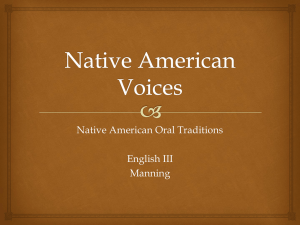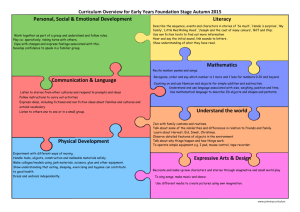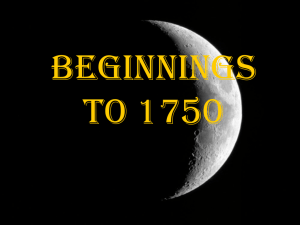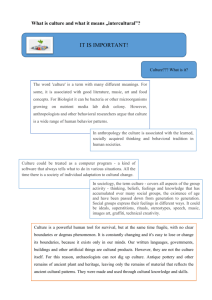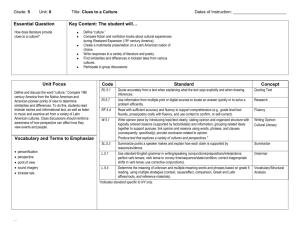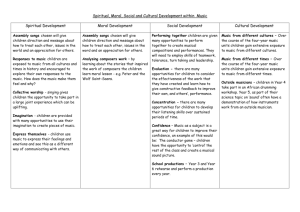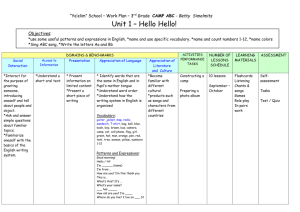Oral Literature and the Oral Tradition
advertisement
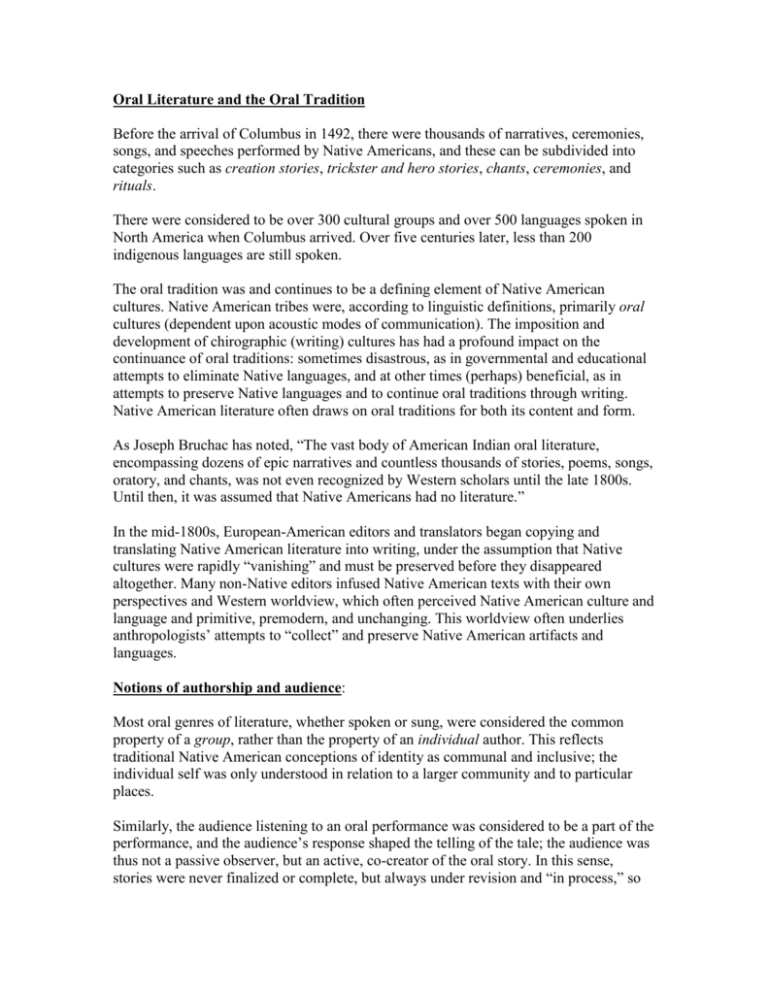
Oral Literature and the Oral Tradition Before the arrival of Columbus in 1492, there were thousands of narratives, ceremonies, songs, and speeches performed by Native Americans, and these can be subdivided into categories such as creation stories, trickster and hero stories, chants, ceremonies, and rituals. There were considered to be over 300 cultural groups and over 500 languages spoken in North America when Columbus arrived. Over five centuries later, less than 200 indigenous languages are still spoken. The oral tradition was and continues to be a defining element of Native American cultures. Native American tribes were, according to linguistic definitions, primarily oral cultures (dependent upon acoustic modes of communication). The imposition and development of chirographic (writing) cultures has had a profound impact on the continuance of oral traditions: sometimes disastrous, as in governmental and educational attempts to eliminate Native languages, and at other times (perhaps) beneficial, as in attempts to preserve Native languages and to continue oral traditions through writing. Native American literature often draws on oral traditions for both its content and form. As Joseph Bruchac has noted, “The vast body of American Indian oral literature, encompassing dozens of epic narratives and countless thousands of stories, poems, songs, oratory, and chants, was not even recognized by Western scholars until the late 1800s. Until then, it was assumed that Native Americans had no literature.” In the mid-1800s, European-American editors and translators began copying and translating Native American literature into writing, under the assumption that Native cultures were rapidly “vanishing” and must be preserved before they disappeared altogether. Many non-Native editors infused Native American texts with their own perspectives and Western worldview, which often perceived Native American culture and language and primitive, premodern, and unchanging. This worldview often underlies anthropologists’ attempts to “collect” and preserve Native American artifacts and languages. Notions of authorship and audience: Most oral genres of literature, whether spoken or sung, were considered the common property of a group, rather than the property of an individual author. This reflects traditional Native American conceptions of identity as communal and inclusive; the individual self was only understood in relation to a larger community and to particular places. Similarly, the audience listening to an oral performance was considered to be a part of the performance, and the audience’s response shaped the telling of the tale; the audience was thus not a passive observer, but an active, co-creator of the oral story. In this sense, stories were never finalized or complete, but always under revision and “in process,” so that a story changed with each telling. Critics have called this process of storytelling dialectical or “dialogic,” because it consists of a dialogue among multiple voices and contains many perspectives. Key Elements of Oral Literature: (Adapted from Joseph Bruchac, “The Sun Still Rises in the Same Sky”): Native American cultures use stories to teach moral lessons and convey practical information about the natural world. A story from the Abenaki people of Maine, for example, tells how Gluskabe catches all of the game animals. He is then told by his grandmother to return the animals to the woods. They will die if they are kept in his bag, she tells him, and if they do die, there will be no game left for the people to come. In this one brief tale, important, life-sustaining lessons about greed, the wisdom of elders, and game management are conveyed in an entertaining and engaging way. Creation myths also convey these lessons, focusing on beliefs about the nature of the physical world; beliefs about social order and appropriate behavior; and beliefs about human nature and the problem of good and evil. American Indian oral literature also reflects a more inclusive, eco-centric view of the natural world than the one typically seen in Western-European literature. The Native American universe is not dominated by human beings. Animals and humans are often interchangeable in myths and folk tales. Origin myths may even feature animals as the instruments of creation and animals often convey wisdom and insight to human beings. American Indian oral literature shows a keen awareness of the power of metaphor. Words are as powerful and alive as the human breath that carries them. Songs and chants can make things happen—call game animals, bring rain, cure the sick, or destroy an enemy. For Native Americans, speech, or oratory—often relying on striking similes drawn from nature—is a highly developed and respected literary form. The Trickster is an archetypal figure in many Native American oral stories, including creation myths and stories that developed post-conquest, to explain (and challenge) the Euro-American invasion of Native land. The Trickster is represented as Coyote in many tales, and is a reminder of the importance of subversive humor in the process of survival. Repetition is a device often used in oral literature, but often lines that are repeated contain different and changing meanings. Repetition is often used to create expectation.
